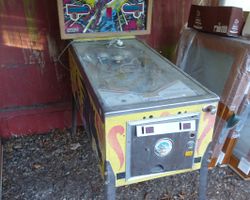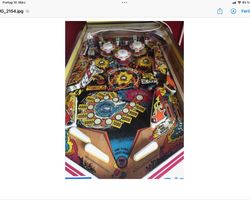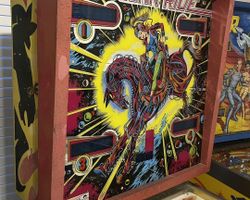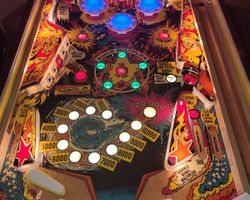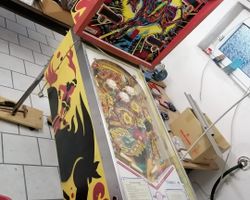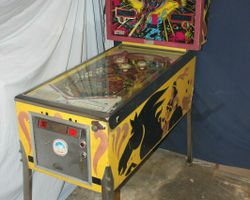Solar Ride
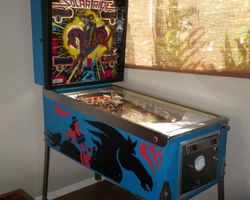
Average Prices: USD $200 to $800
Produced: Febuary, 1979
Production Run: 8,800 units
Machine Type: Solid State Electronic
MPU: Gottlieb System 1
Players: 4
Design by: Ed Krynski
Art by: Gordon Morison
The late 1970s marked a vibrant era for pinball, and among the stellar machines launched during this period was Solar Ride, a captivating creation from D. Gottlieb & Company. Released in February 1979, this solid-state electronic (SS) pinball machine transported players to the vast expanse of outer space, offering a unique blend of engaging gameplay and striking visual design. The thematic inspiration for Solar Ride was clearly rooted in the burgeoning fascination with space exploration and science fiction that permeated popular culture at the time.
The creative forces behind Solar Ride included the design expertise of Ed Krynski, who shaped the gameplay and mechanical aspects of the machine. Complementing Krynski's design was the artwork of Gordon Morison. Morison's artistic vision brought the space theme to life, adorning the backglass and playfield with vivid colors and dynamic imagery characteristic of the late 70s aesthetic.
Solar Ride debuted on February 1st, 1979, quickly becoming available to operators and the public. Priced at $850, it represented a significant investment for operators, yet its engaging gameplay and appealing theme positioned it as a potentially lucrative addition to arcades and entertainment venues. The production of 8,800 units confirms its solid performance in the market, reflecting the machine's popularity and Gottlieb's manufacturing capabilities at the time.
Signature Features and Design
Solar Ride distinguishes itself through several notable features that contribute to its unique identity and gameplay experience. One of the most immediately striking aspects is its artwork. Gordon Morison's backglass design is frequently cited as a highlight of the machine. Employing a comic book-inspired style, the artwork explodes with bright reds, yellows, and contrasting hues, immediately capturing attention. The vibrant color palette and dynamic composition effectively communicate the space theme and create an inviting visual spectacle.
Beyond aesthetics, Solar Ride incorporates mechanical features that define its gameplay. Most notably, the machine is equipped with three flippers, a configuration that was becoming increasingly common, offering players enhanced ball control and shot-making opportunities. Furthermore, the inclusion of a double flipper arrangement on the left side of the playfield presents a distinctive challenge and strategic element. This dual flipper setup demands precise timing and coordination, adding a layer of complexity to ball manipulation and shot execution.
The presence of a 5-bank of drop targets is another signature element of Solar Ride. Drop targets are always a welcome feature in pinball, offering satisfying tactile feedback and clear objectives for players to pursue. In Solar Ride, these targets are integrated into the gameplay in a way that encourages strategic aiming and shot planning. Complementing these features are elements like pop bumpers and kick-out holes, standard components of many pinball machines, yet effectively employed in Solar Ride to create dynamic ball movement and scoring opportunities.
Playfield and Mechanics
The playfield layout of Solar Ride is thoughtfully designed to facilitate engaging gameplay centered around its core features. The three flippers are strategically positioned to allow for a variety of shots across the playfield. The lower two flippers, arranged in the double flipper configuration on the left, demand skillful handling to control the ball and set up shots towards the upper playfield. The single flipper on the right side provides a more conventional control point, useful for direct shots and ball saves.
Scattered across the playfield are three pop bumpers, arranged to create chaotic ball deflection and contribute to bonus accumulation. Two kick-out holes are also present, adding elements of unpredictability and reward. Successfully hitting these holes can trigger various game events or contribute to scoring. The prominent 5-bank of drop targets is positioned in a key area of the playfield, requiring accurate shots to knock them down. Clearing these drop targets often unlocks scoring bonuses or advances game progression.
The artwork integrated into the playfield complements the backglass, maintaining the vibrant color scheme and space theme. Illustrations of planets, stars, and cosmic motifs adorn the playfield surface, immersing players further into the game's narrative. While specific lighting features of Solar Ride are not extensively documented, machines of this era typically employed general illumination and feature-specific lighting to highlight targets and playfield elements, enhancing visual feedback and player awareness. The overall aesthetic of the playfield is clean and functional, prioritizing gameplay clarity while still maintaining visual appeal. The layout encourages players to utilize all three flippers, engage with the drop targets, and navigate the pop bumpers and kick-out holes to maximize their score.
Gameplay Dynamics
Solar Ride's gameplay is characterized by a focus on bonus accumulation and drop target completion. The scoring system is designed to reward players for skillful shot-making and strategic target engagement. While detailed rulesheets from this era can be scarce, player feedback suggests that the primary gameplay loop revolves around hitting drop targets to build bonuses, and then collecting those bonuses through specific shots or actions. The machine's bonus-centric design means that skillful players can quickly rack up substantial points by mastering the drop target sequences and bonus multipliers.
The unique double flipper arrangement adds a layer of skill to the gameplay. Mastering the timing and control required to effectively use these flippers is crucial for advanced play. Players must learn to coordinate the two flippers to make precise shots and avoid draining the ball down the left outlane, a potential hazard given the flipper configuration.
While Solar Ride might not feature complex multi-ball modes or intricate storylines common in later pinball machines, its gameplay is nonetheless engaging in its simplicity. The objective is clear: hit the drop targets, build bonuses, and keep the ball in play. Strategies likely involve prioritizing drop target sequences, learning to control the ball with the double flippers, and utilizing the pop bumpers to extend ball times and increase scoring opportunities. Some players have noted that the gameplay can become repetitive over extended periods due to the relatively straightforward objectives. However, for shorter play sessions or for players who appreciate a more classic and direct pinball experience, Solar Ride offers satisfying and accessible gameplay.
Reception and Legacy
Reception to Solar Ride within the pinball community is somewhat divided, reflecting a mix of appreciation and critique. A recurring point of praise is the machine's artwork. The backglass, in particular, is frequently lauded for its vibrant colors, comic book style, and overall aesthetic appeal. Many consider it a standout example of pinball art from the late 1970s.
However, feedback on the gameplay is more nuanced. While some players find the gameplay enjoyable, especially in shorter sessions, criticisms often center on its perceived repetitiveness. The relatively limited number of distinct shots and objectives, compared to more feature-rich machines, can lead to a feeling of monotony for some players after extended play. The sound effects have also been mentioned as basic, or even somewhat grating to some, which can detract from the overall immersive experience.
Despite these criticisms, Solar Ride holds a place in pinball history and retains a certain charm. Its straightforward rules and clear objectives make it approachable for beginners and families, contributing to its appeal as an entry-level machine or a nostalgic piece for collectors. The bonus-focused gameplay can be rewarding, and the challenge of mastering the double flippers adds a unique skill element. While it may not be considered a complex or deeply strategic pinball machine by today's standards, Solar Ride encapsulates the aesthetics and gameplay sensibilities of its era. Its legacy lies in its visually striking design, its accessible gameplay, and its representation of Gottlieb's System 1 era, contributing to the diverse tapestry of pinball history.
 Active Auctions
Active Auctions
 Auction Results
Auction Results
| Cost | Location | Date |
|---|---|---|
| EUR €369 |  Schlewig-Holstein, Germany Schlewig-Holstein, Germany |
27 February, 2025 |
| EUR €254 |  Schlewig-Holstein, Germany Schlewig-Holstein, Germany |
13 February, 2025 |
| USD $1,000 |  United States United States |
29 August, 2024 |
| EUR €2,499 |  Baden-Württemberg, Germany Baden-Württemberg, Germany |
08 November, 2023 |
| EUR €604 |  Schlewig-Holstein, Germany Schlewig-Holstein, Germany |
12 March, 2023 |
| EUR €604 |  Bayern, Germany Bayern, Germany |
12 February, 2023 |
| USD $150 |  California, United States California, United States |
20 March, 2022 |
| GBP £600 |  Okehampton, United Kingdom Okehampton, United Kingdom |
14 November, 2021 |
| EUR €955 |  Hessen, Germany Hessen, Germany |
15 September, 2021 |
| USD $700 |  Missouri, United States Missouri, United States |
21 December, 2020 |


Private Policy · Search Website · Contact Us
All trademarks and copyrighted materials remain property of their respective owners.
All other content copyright 2007 - 2025 Pinpedia.

